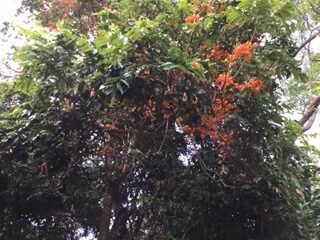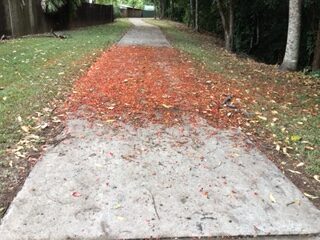(Black Bean, Moreton Bay Chestnut)
Since coming to Cairns from Paluma, I am learning to identify a slue of plants and birds endemic to this region of the tropics. One rainforest tree however, was familiar to me, as it would be to most North Queenslanders: the Black Bean, or Castanospermum australe. It is native to the east coast of Australia in Queensland and New South Wales and to the Pacific islands of Vanuatu, New Caledonia and New Britain. The Castanospermum belongs to the Fabaceae family and has the distinction of being the only species within the genus Castanospermum.
It is a handsome tree, growing up to 35 metres with fairly dense foliage of compound leaves, but the brilliant vermilion and yellow sprays of pea-like flowers are what make this tree so spectacular around this time of year, (September-October). It was a bright carpet of dropped flowers beneath the tree that drew my attention to it. The flowers are followed between March and May with large pods which split to reveal 2 to 3 large brown seeds weighing about 30 grams each. The canoe-shaped pods are easily recognised. The seeds are hairless and reminiscent of chestnuts and look quite appetising; but woe betide anyone who samples one that has not been properly prepared.
The seed is highly toxic. Sulphur-crested Cockatoos eat them but I know of nothing else that does so. Eating one causes vomiting, diarrhoea, severe abdominal pain and dizziness and can be serious if urgent medical attention is not sought. Sawdust from this tree can cause dermatitis, eczema and nasal irritation. The leaves and seeds are poisonous to live-stock.
However, the seed is a highly nutritious food source and the Indigenous people of the North Queensland coastal rainforest devised a sophisticated way of rendering the seeds safe to eat. This involved a sequence of steps which include, roasting the seeds overnight in a ground oven, slicing and mashing, placing in a dilly-bag to leach in running water, and finally pounding the seeds to a flour-like powder.
As far as I know, the poisonous compound in the Black Bean is as yet, unknown. Many of the rainforest trees have chemicals which could potentially be used medicinally and the Castanospermum was mooted as containing chemicals which could be used against AIDS.
Text & Photos by Colwyn Campbell





From my walks along the various track in the Paluma region, I have only seen this tree on the lower slopes of the range. However, there is a tree (probably planted) in the village that drops flowers onto the main road each year. It’s on Mt Spec Road just past the Whaley Rd turn off on the left as you travel towards the Community Hall.